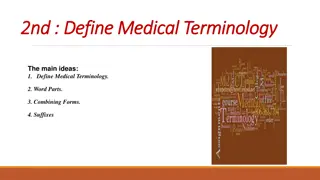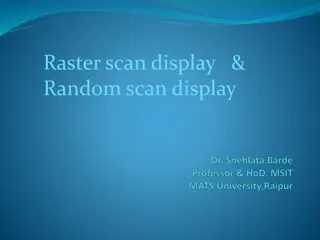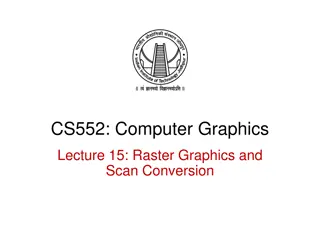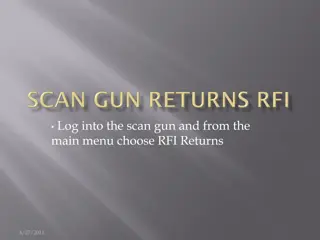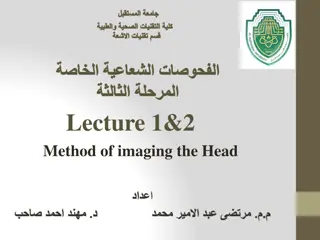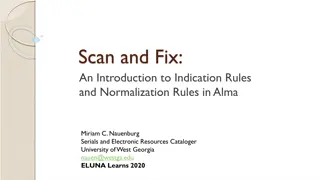Evolution of CT Scan Technology and Terminology
The development of CT scanning technology revolutionized medical imaging. Godfrey Hounsfield introduced computerized axial transverse scanning in 1972, with Allan Cormack's mathematical contributions. Dr. Robert Ledley created the first whole-body CT scanner in 1974. Dr. Willi Kalender further advanced CT with volume spiral scanning in 1989. The terminology includes concepts like translation, rotation, pitch, and substance HU values. A high-kilovolt technique is typically used in CT for better image quality and radiation flux. Explore the history and technical aspects of CT scanning.
Download Presentation

Please find below an Image/Link to download the presentation.
The content on the website is provided AS IS for your information and personal use only. It may not be sold, licensed, or shared on other websites without obtaining consent from the author.If you encounter any issues during the download, it is possible that the publisher has removed the file from their server.
You are allowed to download the files provided on this website for personal or commercial use, subject to the condition that they are used lawfully. All files are the property of their respective owners.
The content on the website is provided AS IS for your information and personal use only. It may not be sold, licensed, or shared on other websites without obtaining consent from the author.
E N D
Presentation Transcript
CT scan Physics CT scan By S.S.Siva Sagar M.Sc RIT 200513001 SGT UNIVERSITY Department of Radiology Centurion University AASIF MAJEED LONE Assistant professor
Introduction At the annual Congress of British institute of radiology , in April of 1972 , Godfrey Newbold Hounsfield, a senior research scientist At EMI limited (Electric and Musical Industries), middlesex, England , announced the revolutionary imaging technique called computerized axial Transverse Scanning. He considered as a Father of Ct scan. Allan MacLeod Cormack developed the mathematics used to reconstruct the images in 1963. Noble prize was given to the discovery in 1979, for both GN hounsfield (UK) and Alan coremack (USA). Perhaps the first significant technical development came in 1974 when Dr. Robert Ledley, a professor of radiology, physiology, and biophysics at Georgetown University, developed the first whole- body CT scanner. (Hounsfield s EMI scanner scanned only the head.)
In 1989, Dr. Willi Kalender has made significant contributions to the introduction and development of volume spiral CT scanning.
Terminology Translation is the linear movement of X ray tube and detector. Rotation is the rotatory movement of X ray tube and detector. Ray refers single transmission measurement. Projection refers series of X rays passes through the patient at the same orientation.
Pitch = table movement per axial scan(table feed) / slice thickness. If pitch increases Radiation dose, Image quality and Scanning time decreases. If increment increases No of images decreases and If increment decreases no of images increases. CT number or hounsfield unit :
SUBSTANCE HU Air -1000 Lung -500 Fat -100 to -50 Water 0 CSF 15 Kidney 30 Blood +30 to +45 Muscle +10 to +40 Grey matter +37 to +45 White matter +20 to +30 Liver +40 to +60 Soft tissue +100 to +300 Bone 1000
In CT, a high-kilovolt technique (about 120 kV) is generally used for the following reasons: 1. To reduce the dependence of attenuation coefficients on photon energy. 2. To reduce the contrast of bone relative to soft tissues. 3. To produce a high radiation flux at the detector.
Basic principle Of CT The fundamental concept is the internal structure of an object can be reconstructed from multiple projections of the object. Computerized tomography means A method Of producing three dimensional images Of internal body structure by two dimensional images (axial images) The Ray projections are formed by scanning a thin cross section of the body with a narrow x ray beam and measuring the transmitted radiation with a sensitive radiation detector. The detector does not form the image. It adds up the energy of all the transmitted photons. The numerical data ray sums are then computer processed to reconstruct an image. Human body is imagined as a matrix and is divided into number of columns and rows. In general, CT scanners used 512 x 512 and 1024 x 1024 columns and rows. Each matrix element is named as picture element ( pixel) in a 2- dimensional concept.
Pixel size is 0.625 mm, Detector size 0.625 mm and minimal slice thickness called pixel size. Volume element (voxel) represents a volume of tissue in the patient and it is three dimensional concept. Voxels are scanned in different directions. Each pixel on the monitor display represents a voxel in the patient. When the voxel dimensions of length, width, and height are equal, that is, describe a perfect cube, the imaging process is referred to as Isotropic imaging. Finally, each pixel in the CT image can have a range of gray shades. The image can have 256 (2 ), 512 (2 ), 1024 (2 10), or 2048 (2 11) different grayscale values. Because these numbers are represented as bits, a CT image can be characterized by the number of bits per pixel. CT images can have 8, 9, 10, 11, or 12 bits per pixel. The image therefore consists of a series of bit planes referred to the bit depth.
Windowing : The CT image is composed of a range of CT numbers (e.g., +1000 to 1000, for a total of 2000 numbers) that represent varying shades of gray. The range of CT numbers is referred to as the window width (WW), and it controls the contrast. The center of the range is the window level (WL) or window center (C), and it controls image brightness. Both the WW and WL are located on the control console. With a WW of 2000 and a WL of 0, the entire gray scale is displayed and the ability of the observer to perceive small differences in soft tissue attenuation will be lost because the human eye can perceive only about 40 shades of gray. The WL or C increases the image goes from white (bright) to dark (less bright); and the image contrast changes for different values of WWs. The image contrast is optimized for the anatomy under study, and therefore specified values of WW and WL or C must be used during the initial scanning of the patient.
Why Is a CT Scan Performed ? A CT scan has many uses, but it s particularly well-suited for diagnosing diseases and evaluating injuries. The imaging technique can help your doctor:- i. Diagnose infections, muscle disorders, and bone fractures ii. Pinpoint the location of masses and tumors (including cancer) iii. Study of the blood vessels and other internal structures. iv. Assess the extent of internal injuries and internal bleeding. v. Guide procedures, such as surgeries and biopsies vi. Monitor the effectiveness of treatments for certain medical conditions, including cancer and heart disease. etc.
Advantages I. II. It is minimal invasive procedure. Relatively inexpensive compared with MRI , PET scanning. III. Rapid acquisition of data and no need for patients to remain for planning process. IV. Better resolution . V. Minimum time taking procedure compared with MRI, PET etc. VI. To overcome superimposition of structures. VII. To improve contrast of the image. VIII.To measure small differences in tissue contrast. and SPECT
The special features of CT image includes 1. Images are crosssectional. 2. Eliminates the superimposition of structures. 3. Sensitivity of CT to subtle difference in x ray attenuation is at least factor 10 higher than x ray film. 4. Higher contrast due to elimination of scatter
TUBE WARM UP PROCEDURE The purpose of an X-ray tube s warm-up procedure is to avoid damage to the X-ray tube and avoid any artifacts in the images acquired. If a cold anode is exposed to high-powered energy, anode damage often occurs. A general recommendation is proposed by all manufacturers for warming of the X-ray tubes by different series of low energy exposures to prevent such type of damage. The X-ray tube s heating procedure is performed by carefully increasing the tube current and voltage, leading to the slow burning of any oxygen molecules present before reaching a safe level for high-powered operation of the tube. The tube is warmed up gradually in a controlled manner, so the tube can reach its operating temperature before scanning a patient.
The CT manufacturers have recommended in the respective CT manuals. Never to perform scanner calibration, scanner testing, or tube heating when a patient or other personnel are present in the CT room. The system operates most efficiently within certain parameters. These parameters are established by warming the tube using a preset group of exposures. When you perform a tube warmup at least once every 24 hours and at any system prompt, it reduces the possibility of image artifacts, and may aid in prolonging the life of the tube. When you start the scan, a series of air scans are performed as part of the tube warm up scans.
HOW CT SCANNERS WORK To enhance understanding of the early experiments and current technology, the technologist must be familiar with the way a CT scanner works. The technologist first turns on the scanner s power and performs a quick test to ensure that the scanner is in good working order. The patient is in place in the scanner opening, with appropriate positioning for the particular examination. The technologist sets up the technical factors at the control console. Scanning can now begin. When X rays pass through the patient, they are attenuated and subsequently measured by the detectors. The x-ray tube and detectors are inside the gantry of the scanner and rotate around the patient during scanning. The detectors convert the x-ray photons (attenuation data) into electrical signals, or analog signals, which in turn must be converted into digital (numerical) data for input into the computer.
The computer then performs the image reconstruction process. The reconstructed image is in numerical form and must be converted into electrical signals for the technologist to view on a television monitor. The images and related data are then sent to the PACS, where a radiologist will be able to retrieve and interpret them. Finally, the image can be stored on magnetic tapes or optical disks
System components in ct CT scan contains following components. 1. Control console. 2. Computer. 3. Couch . 4. Gantry.
Control console There are 3 consoles in ct, one for the technologist to operate the imaging system, one for the technologist to post process images and the other for the physician to view images. Ex : GE CT scan. The operating console is provided with meters , controls for selection of technique factors , movement of Gantry and table couch, image reconstruction commands, selection of kvp and mAs and slice thickness. The Radiologist in control console is used to see the images and write reports. In some institutions, work station provided for reporting of patient scans.
Computer The computer is used to solve more than 2,50,000 equations with the help of microprocessor. The computer system performs image manipulation and various image processing operations such as windowing, image enhancement, image enlargement and measurements, dimensional (3D) imaging, an quantitative measurements. The computer system generally includes input output devices, central processing units, array processors, processors, storage devices, and communications hardware. The computer system also includes software that allows each hardware component to perform specific tasks. The software includes plot of CT numbers, mean and standard deviation of CT values, ROI subtraction techniques , reconstruction of images in coronal, saggital and oblique. multiplanar reconstruction, three- interface devices, back-projector
Couch The couch supports the patient comfortably and it is made up of low Z material like carbon fiber material. It has a motor for smooth patient Positioning. It moves longitudinally through Gantry aperture , indexed automatically and the table top can be removable. The vertical movement should provide a range of heights to make it easy for patients to mount and dismount the table This feature is especially useful in the examination of geriatric, trauma, and pediatric patients. Horizontal or longitudinal couch movements should enable the patient to be scanned from head to thighs without repositioning. Industry standard table weight limits for CT is usually 450 Ibs (205 kg). Newer larger CT scanners are currently available which can accommodate patients weighing up to 680 Ibs (308.4 kg).
Gantry The gantry is a mounted framework that surrounds the patient in a vertical plane. It contains a rotating scan frame onto which the x-ray generator, X ray tube, and other components are mounted. The generator in the gantry is usually a small, solid-state, high-frequency generator mounted on the rotating scan frames. The gantry houses imaging components such as the slip rings, x-ray tube, high- voltage generator, collimators, detectors, and the data acquisition system. Because it is located close to the X-ray tube, only a short high-tension cable is required to couple the x-ray tube and generator. This design eliminates external x-ray control cabinets and long high-tension cables as was typical of the older CT imaging systems.
Gantry cooling is a prime consideration because the ambient air temperature affects several components. In the past, air conditioners were placed in the gantry. Modern cooling systems circulate ambient air from the scanner room throughout the gantry. Most scanners have a 70-cm aperture that facilitates patient positioning and helps provide access to patients in emergency situations. The gantry also includes a set of laser beams to aid patient positioning. Other gantry characteristics include Scan control panels - controls gantry tilt and patient table elevation Scan control box - controls emergency stop, intercom, and scan enable and pause functions Slice position indicator Radiation indicator, and Intercom systems with multilingual autovoice to facilitate communication with the patient in one of several languages.
CT Gantry has the following gadgets. X-ray tube. Collimators. Filters . Detectors. High voltage generator.
X ray tube Ideally , the radiation source for CT should supply a monochromatic x ray beam. With monochromatic x ray beam image reconstruction is simpler and more accurate. Kvp : 80 to 140 kvp Usually operated at 120kV mA : 50 to 1000 mA. Tubes are operated for prolonged exposure time at high mA. There are two focal spot sizes . Hrct uses small focal spot size High speed rotors in tubes for best heat dissipation. The Multislice CT tube is large in size; anode disc is larger in diameter and thickness. The anode heat capacity 8 MHU and the anode cooling is about 1 to 2 MHU.
Collimators Collimation in CT serves to ensure good image quality and to reduce unnecessary radiation doses for the patient. Collimators are present 1. Between the X - ray source and the patient (tube or pre - patient collimators) . 2. Between the patient and the detectors (detector or post - patient collimators). The tube collimator is used to shape the X - ray fan beam before it penetrates the patient. it consists of a set of collimator blades made of highly absorbing materials such as tungsten or molybdenum. The opening of these blades is adjusted according to the selected slice width and the size and position of the focal spot.
Filteration The X - ray photons emitted by the X - ray tube exhibit a wide spectrum. The soft, low - energy X - rays, which contribute strongly to the patient dose and scatter radiation but less to the detected signal should be removed. To achieve this goal, most CT manufacturers use X - ray filters. The Inherent filtration of the X-ray tube, typically 3 mm aluminum equivalent thickness, is the first filter. In addition, flat shaped filters can be used. Flat filters, made of copper or aluminum, are placed between the X - ray source and the patient. They modify the X - ray spectrum uniformly across the entire field of view.
The cross - section of a patient is mostly oval - shaped, so Bowtie filters have an increased thickness from center to periphery, allowing them to attenuate radiation hardly at all in the center but strongly in the periphery. They are made from a material with a low atomic number and high density, such as Teflon.
High voltage generator It is mounted on the Gantry which takes 0.3 secs for 360 degrees rotation. The generator is a high frequency generator with the capacity of 60 KW It provides stable tube current and voltage is controlled by microprocessor. The generator can give a tube current of about 800 mA and 125 KV with pulse duration of 2 to 4 Milliseconds.
Detectors The requirements of CT scan detector are as follows 1. Small in size with good resolution 2. High detection efficiency 3. Fast Response and Negligible after glow. 4. Wide dynamic range 5. Decrease the Noise. There are two types of detectors used in ct scanners. These are 1. Scintillation detectors used in Multi Slice scanners 2. Xenon gas ionization Chambers used in Single Slice Scanners
Scintillation detectors Scintillation crystals are extremely large number of materials that produce light as a result of some external influence. When ionizing radiation reacts with scintillation crystals that produce light (scintillate). The number of light photons proportional to the energy of incident x ray photon. This is just what intensifying screen does. Some of these light photons will be emitted promptly and produce the desired signal.
Some light photons will be delayed and produce produce afterglow. This process done by photomultiplier tubes. The first two generations used thallium - activated sodium iodide scintillation crystals attached to photomultiplier tubes. Sodium iodide crystals have some disadvantages. They are 1. PM tubes are big and not easily fit into the large array of detectors . 2. NaI is hydroscopic and requires air tight container and it has a long afterglow.
There are several possibilities for replacing nai. These include cesium iodide , bismuth germinate and cadmium tungstate. Photomultiplier tubes have been replaced with silicon photodiodes . A photo diode convert a light signal into an electric current or signal.. Photo diodes offer the advantage of smaller size, greater stability and lower cost.
Xenon gas ionization Chambers Any gas filled detector contains 1. An anode and cathode. 2. A counting gas ( inert gas ). 3. A voltage between the anode and cathode. 4. Walls that separate the detector from the rest of the world. 5. A window for the radiation photon to enter the detector.
The photon enters into detector through a window. The photon intercts with a gas atom by ionizing the atom into electron pair. The voltage between the anode and cathode will cause the electron to move toward the anode and the positive ion move towards the cathode. When the electrons reach the anode , they produce small current in the anode. This small current is the output signal from the detector.
Gas filled detectors may operate in one of three modes. 1. For low voltage, only the negative ions produced by the photon are collected by the anode. A gas filled detector operating in this mode is called ionization chamber. The important characteristicis that the current is directly proportional to the intensity of the incoming radiation. 2. At the voltage increases, the ions moving under the influence of the voltage acquire sufficient energy to produce secondary ionization of the gas atoms. In this mode gas filled detector is called proportional counter. It's main characterstic is that output signal is proportional to the energy of photon.
With high voltage , the secondary ionization is so large that the energy proportionally is lost and all incoming photons register the same size pulse. In this mode, the gas filled detector is called Geiger Muller counter. 1. It's main characterstic is large signals that are easily recorded. 2. Hand carried survey meters are this type of detector. The disadvantage of xenon gas detector is a reduced efficacy . The overall detection efficacy is approximately 50 %.
The efficacy can improved by three ways 1. By using xenon , the heaviest of the inert gases. ( Z=54) 2. By compressing the xenon 8 to 10 atmospheric pressure to increase it's density. 3. By increasing the length of the chamber to increase the number of atoms along the path of x ray beam.
1) GEMSTONE DETECTOR (GE) 100 times faster than GOS(0.03 s) 245mm/s scan speed Isotropic ceramic with a highly uniform and translucent cubic structure. Faster light emission and shorter after-glow Clarity DAS enables 25% reduction in electronic noise The Gemstone scintillator escalates response to X-ray excitation, reportedly 50 to 100 times faster than any other detector on the market. The higher speed improves temporal and spatial resolution and reduces electronic noise. This is mostly used in Dual Source or Dual energy CT Scanner.
DETECTOR NEW INTEGRATED MODULE







